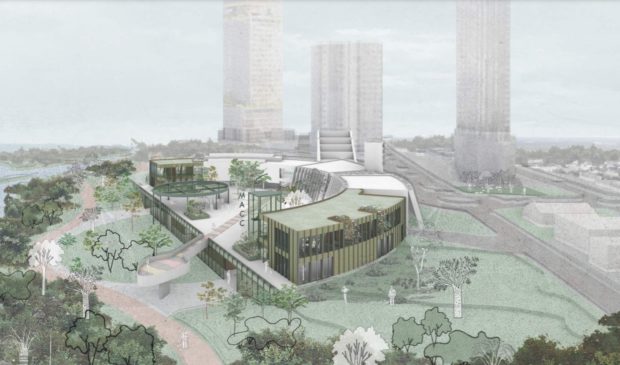MACC expansion plans headed for review
Tuesday, January 25, 2022 by
Chad Swiatecki City leaders are getting an up-close look this week at the project details for the long-planned expansion of the Emma S. Barrientos Mexican American Cultural Center.
The Design and the Hispanic/Latino Quality of Life Resource Advisory commissions are slated to take presentations on the expansion, which adds roughly 68,500 square feet to the 36,000-square-foot facility that is located in the quickly growing Rainey Street district, which was a longtime Latino enclave prior to rezoning that attracted bars and eventually high-rise condominium and hotel developments.
Plans released earlier this month show how the design led by Austin-based Miró Rivera Architects and Mexico City-based architect Tatiana Bilbao would extend the semicircle plan of the MACC to add more performance, rehearsal and classroom space. MACC leaders have joined a chorus of Latino community groups calling for the expansion to address the need for more creative and cultural space at the facility, which is routinely booked years in advance.
A total budget for the expansion that begins construction this fall wasn’t included in the application packet provided to the Design Commission. The city’s website for the phase two project notes that $27 million of its budget will come from the 2018 bond proposal approved by voters for museums and cultural facilities, with additional funding provided by the “remaining unused balance of Proposition Four of the 2006 General Obligation Bond Election, as well as rental proceeds from 64/70 Rainey Street.”
In 2018 the MACC’s advisory board urged the city to allocate $40 million from the bond package to the expansion plans.
One of the more notable architectural features of the project is the creation of a new lower level adjacent to the nearby hike-and-bike trail, and below the zócalo gathering area on the ground level that is used for large events. The lake-level cut allows for the addition of another floor of classroom and other space and creates better control of the flow of attendees for concerts and other events.
Design Commissioner Samuel Franco said the primary needs of his group will depend on how well the project complies with the city’s urban planning guidelines while addressing use of green space, existing building stock and the overall pedestrian environment.
Franco said the expansion serves a critical need for more arts and event space in the city, with a focus on a population that is under increasing affordability pressure.
“The fact that they’re creating more cultural space in Austin at a time when we know that we are losing cultural spaces with iconic music venues getting shut down and it becoming more expensive for artists to get their work made and shown in galleries … this looks like a positive thing for the arts and culture in Austin,” he said.
“I’ve been to many events there and they’ve done wonders with the space that they have, but this new space is going to help so much with additional programming and space for artists in general.”
Ricardo Garay, a member of the Hispanic/Latino Quality of Life Resource Advisory Commission, said he’s most interested in learning about the timelines for construction, the state of fundraising for the project’s overall budget and how it could be impacted by any eventual extension of Red River Street through the district.
“There seems to be a lot of outward pressure from the surrounding neighborhood on the Hispanic community, and that’s why it’s even more important to have a place like the MACC to hold on to the history of Latinx culture and that population in Austin. What’s happening on Rainey is a perfect example of how those things have been wiped out in many parts of the city.”
Project rendering by Miró Rivera Architects and Tatiana Bilbao Studio.
The Austin Monitor’s work is made possible by donations from the community. Though our reporting covers donors from time to time, we are careful to keep business and editorial efforts separate while maintaining transparency. A complete list of donors is available here, and our code of ethics is explained here.
You're a community leader
And we’re honored you look to us for serious, in-depth news. You know a strong community needs local and dedicated watchdog reporting. We’re here for you and that won’t change. Now will you take the powerful next step and support our nonprofit news organization?








